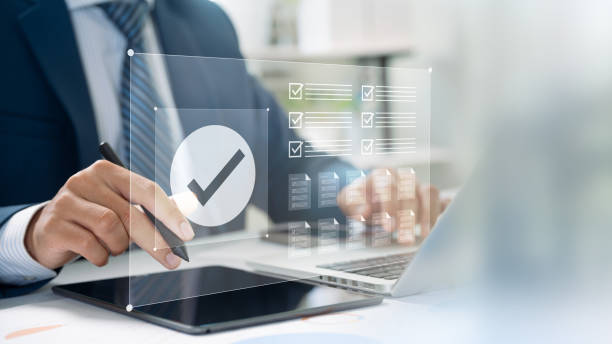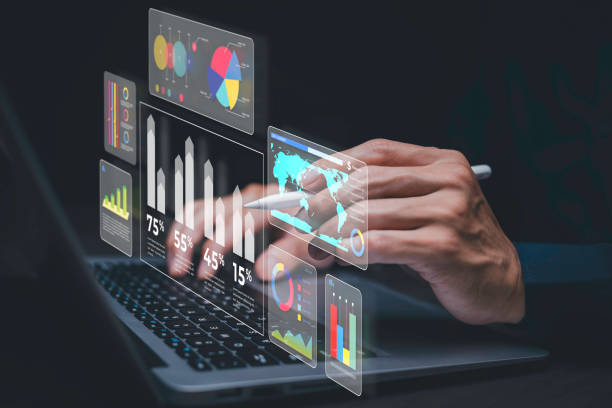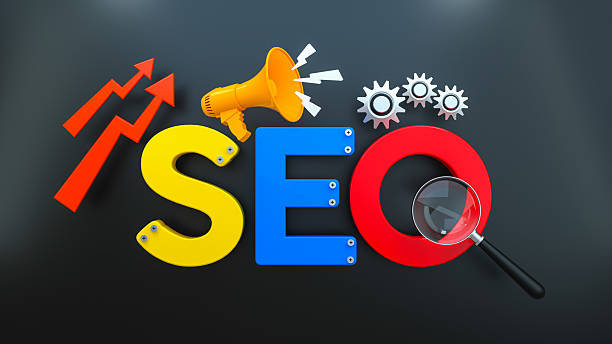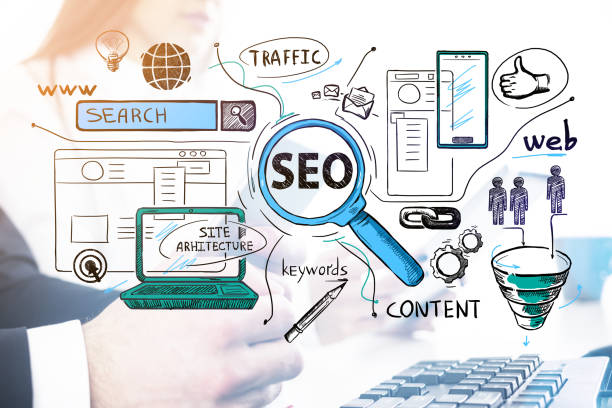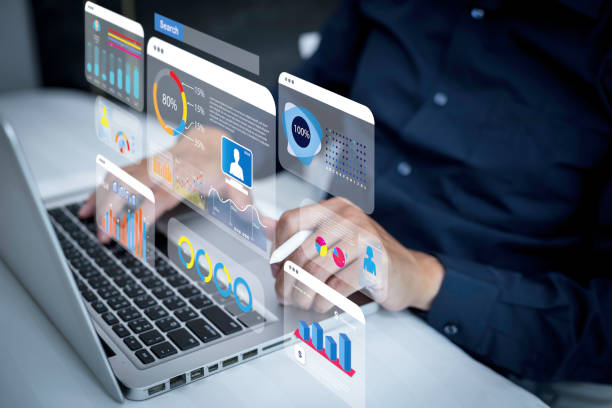What is Internal SEO and Why is it Important?
Internal SEO or On-Page SEO refers to a set of actions taken within a website to improve the site’s ranking in search engine results like Google.
These actions include optimizing content, site structure, HTML tags, loading speed, and other factors that help search engines better understand the site’s content.
The importance of #internal_seo lies in the fact that search engines, by examining these factors, assess the quality and relevance of the site to the user’s search.
Strong internal SEO can significantly increase a site’s ranking, thereby attracting more organic traffic.
In other words, internal SEO is a fundamental foundation for success in online marketing.
Without proper optimization, even the best content may not be seen.
For example, optimizing page titles (Title Tag) and meta descriptions (Meta Description) are among the most important factors in internal SEO.
How much does losing business leads due to a non-professional website cost you? Solve this problem forever with professional corporate website design by Rasaweb!
✅ Increase the credibility and trust of potential customers
✅ Attract new business leads more easily
⚡ Get a free consultation now!
Keyword Research and Its Role in Internal SEO
Keyword research is one of the most important steps in internal SEO.
Keywords are the phrases that users use to search for information on search engines.
By identifying keywords related to your business and website content, you can optimize your content to rank higher in search results for those keywords.
Various tools such as Ahrefs Keywords Explorer and Ubersuggest are available for keyword research.
Once you have identified keywords, you should use them naturally in titles, subtitles, body text, and image alt tags.
However, be careful to avoid keyword stuffing, as this can backfire and cause your site to be penalized by search engines.
Choosing the right keywords is the basis of a successful internal SEO strategy.
Click here to preview your posts with PRO themes ››
Optimizing Website Content for Internal SEO
High-quality and relevant content is the heart of internal SEO.
Search engines are looking for content that answers users’ questions and provides useful information.
To optimize content for internal SEO, you should pay attention to a few points:
- Create unique and valuable content Your content should be new and different from other content available on the internet.
- Proper content structuring Use titles and subtitles (H1, H2, H3) to divide content and make it easier to read.
- Use keywords naturally Use keywords in titles, subtitles, and body text, but avoid overdoing it.
- Optimize images Use appropriate alt tags for images and reduce image size to increase page loading speed.
- Use internal and external links Internal links to other pages on your site and external links to reputable related sites help increase the credibility of your content.
By following these tips, you can optimize your website content for internal SEO and improve your site’s ranking in search results.
| Factor | Description |
|---|---|
| Page Title | Use the main keyword and appeal for clicks |
| Meta Description | An attractive and persuasive summary to click |
| H1-H6 Headings | Content structuring and keyword usage |
Optimizing URLs for Internal SEO
URLs play an important role in internal SEO.
An optimized URL is understandable for both users and search engines.
To optimize URLs, consider the following:
- Use keywords The URL should include keywords related to the page content.
- Be short and concise URLs should be as short and concise as possible.
- Use hyphens (-) instead of spaces Use hyphens to separate words in the URL.
- Lowercase letters Use lowercase letters in URLs.
For example, instead of a non-optimized URL like `example.com/page?id=123`, use an optimized URL like `example.com/seo-dakhli-rahnama`.
This helps search engines better understand the page content and, as a result, improves your site’s ranking.
Internal SEO has principles that help improve the site.
Are you worried about the low conversion rate of your online store and don’t have the sales you want?
Rasaweb is your specialized solution for having a successful online store.
✅ Significant increase in conversion rates and sales
✅ Professional and user-friendly design to satisfy customers
⚡ Ready for a transformation in online sales? Get a free consultation!
Optimizing Images for Internal SEO
Images can play an important role in attracting users’ attention and increasing the attractiveness of website content.
But for images to help your site’s internal SEO, you need to optimize them.
Keep the following in mind:
- Choose the right format Use JPEG formats for high-volume images and PNG formats for high-quality, low-volume images.
- Reduce image size Reduce image size as much as possible to increase page loading speed.
Various online tools are available to reduce image size. - Use alt tag Fill in the alt (alternative text) tag for all images.
This tag helps search engines understand the content of the image and is displayed to users if the image fails to load.
Use keywords related to the image content in the alt tag. - Appropriate filename Optimize the image filename.
Use keywords related to the image content in the filename.
By optimizing images, you can both improve the user experience and help your site’s internal SEO.
The Importance of Website Loading Speed in Internal SEO
Website loading speed is one of the most important factors in internal SEO.
Internet users have little patience, and if a web page loads slowly, the likelihood of a user leaving it is very high.
Search engines also attach great importance to website loading speed, and websites with high loading speeds rank better in search results.
To improve website loading speed, you can take the following measures:
- Optimize images Reduce image size and use appropriate formats.
- Enable Gzip compression Gzip compression can reduce the size of website files and increase loading speed.
- Use CDN A CDN (Content Delivery Network) is a network of servers that stores your website content around the world and chooses the closest server to users to load the content.
- Optimize code Optimize your website’s HTML, CSS, and JavaScript code and avoid unnecessary code.
- Use caching By using caching, users’ browsers can store website files, and loading speed will increase on subsequent visits.
Various tools such as Google PageSpeed Insights and GTmetrix are available to check website loading speed and provide suggestions for improving it.
Internal SEO and website speed are two sides of the same coin.
Optimizing Responsive Website for Internal SEO
With the increasing use of mobile devices to browse the internet, optimizing a responsive website (Responsive Design) has become especially important for internal SEO.
A responsive website is designed to automatically adapt to the screen size of different devices (mobile phone, tablet, computer) and provide a good user experience.
Search engines, especially Google, prioritize responsive websites and give them a higher ranking in search results.
To ensure that your site is responsive, you can use the Google Mobile-Friendly Test tool.
Internal SEO with responsive design can attract more users.
| Feature | Description |
|---|---|
| Flexible Layout | Website elements change according to screen size. |
| Flexible Images | Images automatically resize to fit the screen. |
| Media Queries | Using CSS to apply different styles based on screen size. |
Internal Link Structure and Its Impact on Internal SEO
Internal Links are links that point from one page on your site to other pages on the same site.
A good internal link structure can help search engines better understand your site’s structure and identify more important pages.
Also, internal links can help users easily navigate your site and view more content.
To create a good internal link structure, keep the following in mind:
- Linking to related pages Only link to pages that are related to the content of the current page.
- Using appropriate link text The anchor text should describe the content of the page you are linking to.
- Creating a hierarchical structure Place more important pages at the top of the site’s hierarchical structure and link to them from other pages.
- Avoiding overuse of internal links Avoid overlinking to other pages.
A strong internal link structure is one of the main pillars of internal SEO.
Keep search engines and users happy.
Don’t have a corporate website yet and are missing out on online opportunities? With professional corporate website design by Rasaweb,
✅ Double the credibility of your business
✅ Attract new customers
⚡ Free consultation for your corporate website!
The Importance of Using Schema Markup in Internal SEO
Schema Markup is a type of code that allows you to provide more information about your page content to search engines.
Using Schema Markup, you can tell search engines that your page is about a product, an article, an event, a recipe, or any other type of content.
This helps search engines better understand your page content and display it in a better way in search results (for example, displaying rating, price, number of reviews, etc.).
Using Schema Markup can increase your site’s click-through rate (CTR) in search results and attract more organic traffic.
Internal SEO and schema markup improve site ranking.
Analyzing and Continuously Improving Internal SEO
Internal SEO is an ongoing process and requires continuous analysis and improvement.
To make sure that your efforts in internal SEO are paying off, you should regularly check your site’s performance and identify its strengths and weaknesses.
Various tools such as Google Search Console and Google Analytics are available for analyzing site performance and checking traffic, keyword ranking, bounce rate, and other important metrics.
Using these tools, you can identify problems with your site’s internal SEO and take the necessary steps to fix them.
Remember that internal SEO is not a one-time process, but an ongoing effort that requires patience.
By continuously monitoring and improving, you can significantly increase your site’s ranking in search results and attract more organic traffic.
Always strive to improve internal SEO.
Frequently Asked Questions
| Row | Question | Answer |
|---|---|---|
| 1 | What is On-Page SEO (Internal SEO)? | Internal SEO refers to a set of actions that are performed within the website (on its pages) to improve the site’s ranking in search engine results. This includes content optimization, site structure and HTML codes. |
| 2 | Why is internal SEO important? | Internal SEO helps search engines better understand the content of the page and determine whether that page is relevant and valuable to user searches. This better understanding leads to a higher ranking. |
| 3 | What is the first and most important step in internal SEO? | Keyword Research is the most important initial step. By finding the right keywords, you can produce targeted and relevant content to meet the needs of users. |
| 4 | What is the role of the Title Tag in internal SEO? | The title tag is one of the most important ranking factors and should include the main keyword. This tag is displayed as the page title in search results and affects the click-through rate (CTR). |
| 5 | What is the importance of Meta Description? | The meta description does not directly affect ranking, but by providing an attractive summary of the page content in the search results, it can encourage users to click and thus increase the click-through rate (CTR). |
| 6 | Why is the use of headings (H1, H2, etc.) important in content? | Headings help structure the content and improve readability for users and search engine crawlers. Using keywords in headings also helps search engines better understand the topic. |
| 7 | What does image optimization include in internal SEO? | Includes compressing images to reduce size, using descriptive and related filenames, and filling in Alt tag (alternate text) with relevant keywords to help search engines understand the image content. |
| 8 | What is meant by internal linking in internal SEO? | Internal linking refers to creating links between different pages of a website. This helps to distribute page authority (Link Equity), improve the user experience, and help search engine crawlers discover new pages. |
| 9 | Why is page loading speed important for internal SEO? | Page loading speed is a direct ranking factor and strongly affects the user experience. Slow pages can increase bounce rate and decrease user engagement. |
| 10 | What role does quality content play in internal SEO? | Quality content that is comprehensive, unique, and valuable to the user is the core of internal SEO. This content not only attracts and retains users, but also sends positive signals to search engines and helps to improve ranking. |
And other services of Rasa Web advertising agency in the field of advertising
Smart digital branding: professional optimization to improve SEO ranking using real data.
Smart SEO: designed for businesses looking to increase sales through Google Ads management.
Smart Conversion Rate Optimization: a fast and efficient solution for user engagement with a focus on attractive UI design.
Smart Sales Automation: a new service to increase click-through rates through marketing automation.
Smart Direct Marketing: professional optimization to improve SEO ranking using Google Ads management.
And over a hundred other services in the field of internet advertising, advertising consulting and organizational solutions
Internet advertising | Advertising strategy | Advertorial
Resources
Zoomit Internal SEO Checklist
,What is Internal SEO? SEO Master
,Internal SEO Training (On Page SEO) from Zero to Hundred – Aparat
,What is Internal SEO or On Page SEO? – Nakhle Sabz
? Rasaweb Digital Marketing Agency is here to help you excel in the digital world and achieve unprecedented success with its expertise and experience. From user-friendly website design and SEO optimization to the implementation of targeted advertising campaigns, we are ready to transform your brand in the online space and pave the way for sustainable growth.
Contact us for consultation and services.
📍 Tehran, Mirdamad Street, next to the Central Bank, South Kazerun Alley, Ramin Alley No. 6

